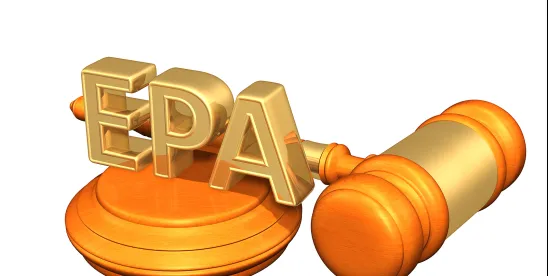The U.S. Environmental Protection Agency’s (EPA) Risk Management Program (RMP) regulations, 40 C.F.R. Part 68, appear to be headed back to rulemaking. These much-debated provisions have been amended, rescinded, and reinstated. EPA will now reassess them, according to a recent EPA filing in the D.C. Circuit and an EPA statement. This reassessment is one of 31 actions EPA plans to undertake according to Administrator Lee Zeldin’s March 12 announcement. EPA expects to publish a final rule in late 2026. Companies subject to RMP should stay alert for developments.
To get a fuller picture of what’s going on, this alert provides a brief history lesson on RMP rulemaking.
Getting Started
The Part 68 regulations, captioned Chemical Accident Prevention Provisions, implement section 112(r)(7) of the Clean Air Act. That provision was added by the Clean Air Act Amendments of 1990, enacted under the first President Bush. The Clinton EPA adopted the original RMP regulations in 1994 (list of regulated substances) and 1996 (accident prevention regulations). Among other things, the 1996 regulations adopted Program 3 requirements based on OSHA’s process safety management (PSM) standard, 29 C.F.R. § 1910.119, including requirements for process hazard analyses (PHAs). They also required the development of risk management plans and public availability of those plans.
Concerns about the public information requirements led to enactment in 1999 of the Chemical Safety Information, Site Security and Fuels Regulatory Relief Act (CSISSFRRA), 42 U.S.C. § 7401 note. It limited public access to the offsite consequence analysis information portion of risk management plans.
The Obama EPA
In 2013, President Obama issued Executive Order 13650, Improving Chemical Facility Safety and Security. The order directed EPA, OSHA, and other agencies to “develop options for improved chemical facility safety and security that identifies improvements to existing risk management practices,” and then develop an effective implementation plan.
In response, in 2017, the Obama EPA adopted regulations to amend Part 68. The final amendments appeared in the Federal Register a week before the (first) inauguration of President Trump. The amendments added requirements for the following, among other changes:
- Safer technology and alternative analyses (STAAs) by chemical manufacturers, paper manufacturers, and petroleum and coal products manufacturers, including consideration of inherently safer technology, as part of their PHAs;
- Third-party audits (rather than self-audits) in some circumstances;
- Emergency response coordination with local authorities, including emergency response exercises;
- Public availability of Risk Management Plans and chemical hazard information.
All these provisions had 2021 or 2022 compliance dates.
The First Trump EPA
The 2017 amendments were not effective at the time of President Trump’s inauguration. Further delays in the effective dates and related rulemaking and litigation followed that inauguration.
The Trump EPA rescinded the 2017 amendments in December 2019, stating:
EPA is rescinding recent amendments to these regulations that we no longer consider reasonable or practicable relating to safer technology and alternatives analyses, third-party audits, incident investigations, information availability, and several other minor regulatory changes. EPA is also modifying regulations relating to local emergency coordination, emergency response exercises, and public meetings. In addition, the Agency is changing compliance dates for some of these provisions.
The 2019 recission amendments took effect upon publication, and thus before the compliance dates for the principal changes made by the 2017 amendments.
However, the recission rule came too late to affect a requirement that took effect in 2018. To date, 40 C.F.R. § 68.10(b) still provides:
By March 14, 2018, the owner or operator of a stationary source shall comply with the emergency response coordination activities in § 68.93, as applicable.
The Biden EPA
Judicial review of the 2019 recission rule (as well as of the 2017 amendments) was ongoing when President Biden was inaugurated. At EPA’s request, the cases were held in abeyance.
In 2022, the Biden EPA proposed essentially reinstating many of the 2017 provisions, including those for STAA, third-party audits, and public availability of information, albeit with some revisions. EPA finalized this reinstatement rule in March 2024. It took effect in May 2024, but with extended compliance dates, as set forth in amended 40 C.F.R. § 68.10:
(g) By May 10, 2027, the owner or operator shall comply with the following provisions promulgated on May 10, 2024:
(1) Standby or backup power for continuous operation of monitoring equipment associated with prevention and detection of accidental releases from covered processes in §§ 68.50(a)(3) and 68.67(c)(3);
(2) Third-party audit provisions in §§ 68.58(f) through (h), 68.59, 68.79(f) through (h), and 68.80;
(3) Incident investigation root cause analysis provisions in §§ 68.60(h) and 68.81(h);
(4) Safer technology and alternatives analysis provisions in § 68.67(c)(9) and (h);
(5) Employee participation provisions in §§ 68.62 and 68.83;
(6) Emergency response provisions in §§ 68.90(b) and 68.95(a); and
(7) Availability of information provisions in § 68.210(d) through (h) ….
(i) By May 10, 2028, the owner or operator shall comply with the risk management plan provisions of subpart G of this part promulgated on May 10, 2024.
In May, 2024, 13 states and the Arizona Legislature filed a petition for review of the reinstatement rule in the D.C. Circuit. State of Oklahoma v. EPA, No. 24-1125 (filed May 9, 2024). Also in May, some industry groups filed their own petition for review. National Association of Chemical Distributors v. EPA, No. 24-1127 (filed May 10, 2025). The cases have been consolidated.
The industry groups submitted a petition for reconsideration of the reinstatement rule in May 2024. The Biden EPA denied that petition in December 2024.
The Second Trump EPA
While the 2024 reinstatement rule is effect now, compliance dates for most of the requirements are still over two years in the future.
The May 2024 effective date meant that the reinstatement rule was not affected by the 60-day Regulatory Freeze issued by President Trump on January 20, 2025 for published rules that had not yet taken effect. It also meant that the rule was beyond the reach of congressional disapproval under the Congressional Review Act, 5 U.S.C § 892.
In February 2025, the industry groups that had filed a petition for review of the reinstatement rule filed a petition for review of EPA’s denial of their petition for reconsideration. National Association of Chemical Distributors v. EPA, No. 25-1075 (D.C. Cir., filed Feb. 24, 2025). No briefs have been filed in any of the court cases related to the 2024 reinstatement amendments.
On March 6, 2025, EPA filed an unopposed motion to hold the first two cases in abeyance (with status reports every 90 days) “while EPA undertakes a new rulemaking to reassess elements of the underlying rule challenged here.” The motion explained:
EPA intends to undertake a new notice-and-comment rulemaking to reassess the requirements in the Final Rule in light of the new Administration’s policy priorities …. EPA intends to complete this rulemaking as expeditiously as practicable and aims to publish a Final Rule in late 2026.
The D.C. Circuit granted that motion on March 11, 2025. The next day, on March 12, 2025, EPA Administrator Zeldin announced that among “31 historic actions in the greatest and most consequential day of deregulation in U.S. history” would be:
Reconsideration of Biden-Harris Administration Risk Management Program rule that made America’s oil and natural gas refineries and chemical facilities less safe (Risk Management Program Rule)
In the meantime, a coalition of industry groups submitted suggestions for a reassessment rule to the Trump EPA in a January 30, 2025 letter to Administrator Zeldin:
1. Immediately shut down and remove the Risk Management Public Data Tool from EPA’s website.
2. Meet with us to discuss how best to initiate a rulemaking to correct the following provisions of the Biden EPA rule:
a. Safer Technologies and Alternatives Assessment provisions, including the practicability assessment requirements
b. Information Availability of sensitive chemical hazard information
c. Third-Party Audit Requirements
d. Process safety information requirements
e. Declined recommendations documentation and disclosure requirements
The first Trump EPA took almost two years to finalize its 2019 rule rescinding many of the 2017 amendments. The second Trump EPA projects that it will take less than two years to finalize its reassessment rule, which would be a few months before the May 2027 compliance date for most of the provisions likely to be reassessed.







 />i
/>i

